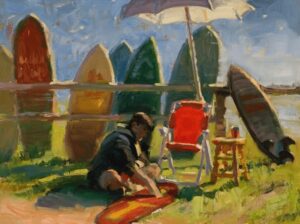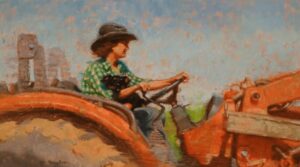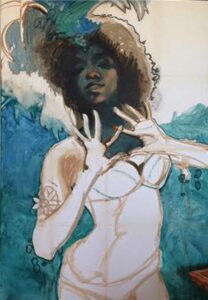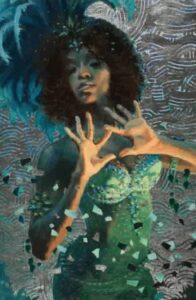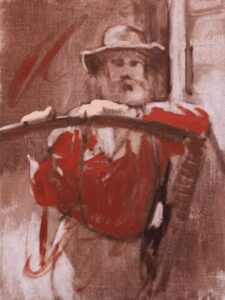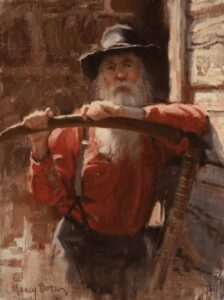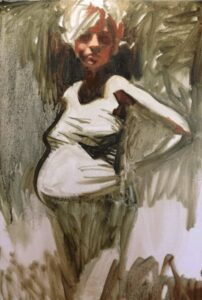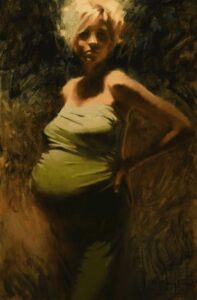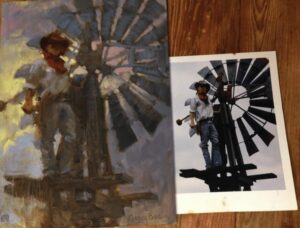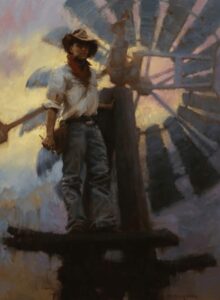
by James Francis Danby
(1816-1875)
When faced with a disaster, what would you save? Who hasn’t considered this classic rhetorical question? What would you rescue as you ran out the door in an emergency? Obviously the people and pets. But then it gets harder, and personal. The computer? Financial paperwork? Family heirlooms? Photo albums?
At the end of September, the question became real for me.
My husband Jack and I live on a boat about half the year. Having spent the summer aboard in Maine, we planned to take ‘Seadragon’ south for the fall and winter. Delayed by hurricanes Irma, Jose, and Maria, we were anxious to get underway and decided to do an overnight run from Portland to Provincetown. Fully fueled, we left about 5pm, a bit before sunset. As we approached the Cape Elizabeth lighthouse, I heard a soft ‘pop’ and a change in the engine sound. After checking with my husband at the helm, I headed for the engine room below deck. The porthole viewing window into the engine room was full of smoke and dripping from what I guessed was our fire suppressor. I didn’t open the door.
Running back up to the flybridge with the bad news, we began doing the things you hope you never have to. Jack shut down the engines and called a mayday to the Coast Guard, letting them know we might be abandoning ship. I got our life jackets and ‘ditch kit’, which holds some survival gear. We deployed the life raft. Then: are we ready? What else might we need? What was I not willing to lose? I grabbed our wallets – ID and a credit card would be nice if we were going to be ashore without a home, clothes or food. Still time? Glancing around I rejected clothes, medicine, and souvenirs. Those could all be replaced. Then I remembered – my Painting! The one I had ready to ship to OPA’s Eastern Exhibition in a couple of weeks! No question, that had to be the one thing I would grab. And there was time – barely.
As I stood on the deck, painting tucked under my arm, ready to jump, I was so sad to be leaving our boat, perhaps forever. Rescuing the painting eased that sense of loss and I knew I had made the right choice for me, on that day. Another time maybe it will be different. Of course, I’m actually hoping there won’t be a next time.
What happened next? Well, as I stood there, the Coast Guard arrived, my heroes! We had a scary transfer, jumping from our deck to theirs – but we all made it. Me, my husband, and the painting. The Coast Guard guys wondered what on earth they were protecting, ‘Must be really valuable’ they said. Yes. To me, it was.
And the rest of the story: The Portland fire boat arrived and our boat didn’t sink – it was towed back to the docks. We lost our life raft, had damages to repair, and weren’t real sure when we would get underway again. But we were fine, got to celebrate a warm welcome back to shore by wonderful people, and I still had a painting to show. It’s called “Potions” – but I’m thinking “Lucky Charm” might be its subtitle.

9×12, oil on panel
There were many lessons tucked into that day, from the Boy Scouts “Be Prepared”, to the philosophical “it could have been worse”. But the one I want to share is that while possessions have little value in a life-threatening situation, the work that we do as artists is more than an end product. It is a representation of how we spend our time, how we see the world, and what we want to share with the world. Our work is important, and worth saving.
We are so fortunate to have had only a close call. Our boat didn’t sink, and our situation pales in comparison to the stories of thousands of people who lost everything to the recent hurricanes and the west coast fires. For each of these families the question of what to save was real, and many didn’t even get the chance to answer the question. My heart goes out to all those who’ve lost their homes.
Archives for November 2017
Nancy Boren interview
I don’t remember when I first met Nancy Boren, but it was many years ago. I actually met her parents, Jim and Mary Ellen Boren, before I met her. It was in 1984 that I met them after being invited to go to Spain and Portugal for two weeks of painting with a group of amazing artists that annually participated in the Western Heritage Sale. They were on that trip.
Jim Boren was the first art director of the National Cowboy Hall of Fame in Oklahoma City. He provided expertise and leadership in assembling the Hall’s fine art collection and exhibits. In 1968, he became a member of the Cowboy Artists of America. His favorite medium was watercolor. So, Nancy grew up around art and the western themes painted by her father. Although she has found her own voice, the influence from her childhood remains. At this year’s Oil Painters of America National Show, Boren was a huge winner, taking the Bronze Medal and Artist’s Choice awards for her painting “Thunder on the Brazos.”
Her greatest passion as an artist is figure painting. Although she has many interests and her painting subjects do vary, she’s most attracted to sunlight and often depicts her subjects in direct light. Three artists she would like to spend a day with are: Nicholai Fechin in Taos, Emily Carr in a British Columbia native coastal village, and Childe Hassam on Appledore Island.

When I asked her how she typically works with clients that commission a painting, I really enjoyed her answer. In a humorous way, I am contemplating just which dogs she might be speaking of. “I almost never do commissions. My heart just isn’t in it. I used to do pet portraits, and when I did those, I would take lots of photos in different lighting situations, then do a 5 x 7 oil sketch. After approval, I did the larger painting. Occasionally the clients also bought the sketch to take to their office or lake house. Much patience and time was required; however, I really did meet some great dogs.”
I know you’ll enjoy this interview with Nancy Boren; with pleasure I bring it to you.

30″ x 24″ – Oil
(Bronze Medal, Artist’s Choice Award – 2016 Oil Painters of America National)
What is your definition of art?
Art is a creation that must contain beauty. Not necessarily beauty in the subject, but in the presentation and execution of the idea. John P. Weiss says that people long for beauty and creative expression. They want to be moved, inspired and shown the hopefulness of art and I agree with that.
“I have had the great good fortune to be born in a place and a time where the luxury of being an artist is a possibility. I am one because I have the opportunity to be what I was born to be.”
Your Dad was a well-known, very accomplished artist; what influence did he have on you becoming an artist and doing the type of work you’re doing today?
He was a huge influence. I grew up seeing him happy, productive and successful. Like him, I also enjoy doing art in a traditional vein and have been familiar with wide open spaces and western subjects all my life. Of course I also paint more exotic figures from time to time.

30″ x 32″ – Oil
When I started doing the pieces for my first show with my dad in about 1978 for some reason (safety?) I did ink and watercolor wildflowers similar to botanicals. Next I started doing watercolors of old interesting buildings, the Taos pueblo, and landscapes. I had used wc growing up and my dad did watercolors as well as oils, so it seemed easy and familiar. In college at Abilene Christian we never did an oil, only acrylics in the painting classes and I found I didn’t like acrylics at all. I later started painting in oils, I don’t even remember how that came about, I just did it. I didn’t want to do the same subjects as my father, but I was in the same galleries so it was a bit perplexing as to how to establish my own identity. I just went at it one painting at a time, but I liked cowgirls — I lived in Texas for goodness’ sake — and so I finally started doing them because that was a western subject my dad never did. Costumes and hats appeal to me in figurative work so it was a perfect fit.
You seem to be equally attracted to landscape and figurative subjects; what is the attraction to each?
I love figure painting the most, but I love landscapes also. One is a nice change from the other. I need variety.

Maine (Plein Air)
9″ x 12″ – Oil
(Finalist, Bold Brush Competition –
Dec. 2015)
I do paint from life and attend figure painting sessions but most of the paintings I put in shows are done based on photographs. Some would just be impossible for me to do otherwise — especially people on windmills or figures jumping.

34″ x 38″ – Oil
(Gold medal for Signature Members of American Women Artists Show – 2016)
“I hope my work shows how intriguing I find the world.”
You have created several very impressive figurative paintings with windmills…very interesting and compelling compositions. How were these set up and accomplished?
I decided I wanted to do a windmill piece and so I googled windmills. I found a place a couple hours from me that has a whole group of them and the public is welcome. I take my models or have them meet me there. Then I stand on the ground and direct them, and take lots of photos.
Do you have a pretty clear concept in mind before beginning a painting; if so, how do you work out your concepts?
I usually do have a clear concept in mind. I do most of it in my head. I may cut up a photo I have printed out, or paint over part of the photo, or do some erasing in photo shop (but I am far from a tech guru so the simple way is how I approach it). I know people tout the great benefits of thumbnails, but every time I try them I get annoyed and disgusted because they don’t look anything like the finished product I want and so as a result I would rather work out things on the painting itself. I try to look on the bright side, because when I leave bits of the original color showing through and around the changes, the painting is actually more interesting than it would have been had everything been perfectly planned out at the start. At some point after you learn how to do things conventionally and correctly, you have to embrace your own quirkiness and go with it. For a few larger paintings, I have done small studies (8 x 10 up to 12 x 16).
12″ x 16″ – Oil
(Honorable Mention, Plein Air Southwest Salon – 2016)
20″ x 36″ – Oil
How do you come up with your ideas?
Two ways: I see something that would make a good painting, or more often, I set my mind to work on coming up with something. I think while I drive, and I look for things to spark ideas. I love this quote by Thomas Edison: “To be an inventor you need an imagination and a pile of junk.” My junk pile is composed of colors, shapes, outfits, people, weather, animals, stories, and props. I love treasure hunting on back roads, antique stores, on walks with my dog…everywhere. One fascinating object can give me a painting idea.
What is it that you primarily want to communicate through your work?
The immediate answer would be for each painting to convince a collector to take it home. But the larger answer would be sharing an honest delight in the world and the hope that my slice of life will resonate with someone else out there. And I hope that the blood, sweat, and tears that went into it are transformed into convincingly light, right strokes of paint.
“Artists of all kinds add the spice, the eye-opening moments, the richness to life.”
What’s the major thing you’re looking for when selecting a subject?
Many times I think in terms of silhouettes. An interesting silhouette like a windmill always grabs my attention.
Please explain your painting process. Does the process differ when working plein air versus studio?
I pretty much start the same way no matter what color scheme, size, or location. I draw with thinned oil paint (often a transparent color like olive green or a mix with transparent oxide brown) to get all the big shapes in place, sometimes on a toned canvas, sometimes not. Then I use more thinned paint to get the darks and colors suggested before beginning to paint with thicker pigment. Lots of times I start with the focal point, but sometimes I work around it. I would say it is the approximate trial and error system. I can’t completely finish one area with white canvas surrounding it before going on to finish another area; that just does not work for me.
36″ x 24″ – Oil
silver metal leaf
16″ x 20″ – Oil
How do you decide on a color scheme for each painting?
If I see something beautiful I may try to replicate the effect, so the subject informs the color choice. Sometimes I want to paint something red because I have just finished a painting with a lot of green and I am sick of green. When I am frustrated with color I go to a limited palette to give my brain a rest and to enjoy the subtle surprises those color schemes hold.
What colors are typically found on your palette? Why these colors?
Zinc-titanium white mix, cad yellow light or medium, cad yellow dark, orange, yellow ochre, cad red light, permanent alizarin, sometimes cad red deep, burnt sienna, transparent oxide brown, cobalt or ultramarine blue, sometimes manganese blue, sometimes olive green, ivory black. Sometimes a few others also, but I don’t use everything on every painting. I use a Zorn palette on occasion. Through the years colors have come and gone.
What are the compositional guidelines you always adhere to when
designing a painting?
I doubt I always adhere to any guidelines. I do try to stick with odd numbers of things instead of even and I try to use repetition. I try to have only 3 or 4 big areas of value.
I have attached the original photo I used that I took with my cousin posing on a windmill as well as the 16 x 12 color study. The photograph shows that is was an ugly gray day with virtually no color in the sky or anywhere else. As we drove away, the sun snuck out from between the clouds for a moment and so the sky was reconstructed and enhanced from my quick glimpse of it.
The photo, used as reference for “Aloft in the Western Sky”, shows Boren’s cousin posing on a windmill. Next to it is her 16″ x 12″ color study. Boren says it was an ugly gray day with virtually no color in the sky or anywhere else. As we drove away, the sun came out from between the clouds for a moment, so the sky was reconstructed and enhanced from my quick glimpse of it.
How has your plein air work informed your studio creations?
Cameras are great for detail and lots of information, but plein air studies are great for feeling and color. I have done paintings using a combination of the two: plein air for the color and photos for the arrangement (especially of things blowing in the wind).
Do you have a marketing strategy for promoting your work?
Perseverance is always key. I try to do quality work, get in quality shows and galleries. I do have a web site, which I keep reasonably updated. I post on Facebook and Instagram, and I enter competitions, as well as belonging to several national groups. Good things have happened as a result of several of those areas. Honestly, I am more concerned about my next painting than about my next marketing effort.
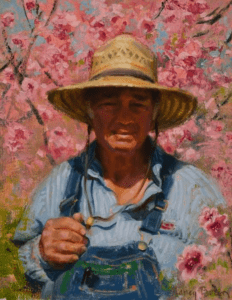
Start today. Even if you can only work a short time each day, start. And use what is at hand, like the children. They will grow up so fast, time is of the essence. A tremendous amount can be accomplished in small spaces and in small blocks of time and there is nothing wrong with doing small pieces that can be finished quickly. Donna Howell-Sickles used to get up at 4:00 in the morning to have two uninterrupted hours in the studio before her daughter got up. I don’t know that I would have had that kind of dedication but I do believe in just doing it; figure it out as you go.
If you were stranded on an island, what three books would you want with you? How to Survive being Shipwrecked and Get Rescued, one of my scrapbooks of art I have clipped out of magazines, and Night Circus.
What’s a typical day look like?
Every day is different. I do love days when I don’t have to leave the house (where my studio is) except to take a walk. I often run errands in the morning because I am an afternoon person. My husband gets home from work at 7:00 so I can get a lot done after lunch.
Nancy, thank you for a great interview. Your plain spoken, down-to-earth responses will be greatly appreciated by the readers of this blog.
